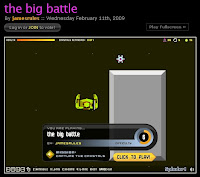Of everything, I do have to compliment this site's creators for the large background image which blends between gaming imagery, whilst using transparency bars for the menu. It's my achilles heel after all. Using a three colour palette of black, blue and yellow, the latter is instantly recognisable and stands out, proving a good divider bar.
The site uses a traditional nav bar at the top, which is clear and easy to understand. Noticeably, the login function isn't behind a button, but instead close to the top of the main page.
The pages tend to hold a lot of information and using a smaller font adds to the information packed feel of the site. Likewise, the use of images, which aaccompany every bit of text, again make the site feel fuller.

In terms of the players list, they have gone for a look much like Facebook - a list. Along with the username, they add favourite games, and even a status update per brief display. It wouldn't be unexpected for this to be linked in with Facebook, as the layout and information seem so similar.
Raptr goes for a more information lead approach in regards profile information. The activity feed makes the page quite lengthy, whilst the profile picture, username and other brief stats are placed neatly in the top right hand corner. With the priority of the site being about gaming and what the user is playing, this seems a sensible choice. However, I would prefer the gamer information atop such information.
Oncemore, the game thumbnails are very small. The black, white and orange look is quite modern, but the use of capital italics is unusual for a site that you would expect to be in keeping with modern webdesign conventions. In fact, italics form a large part of the site's typography. It isn't something I am keen on, whilst important links in orange are not instantly easy to read.
However, I do like the quick access bar that can be opened by clicking at the bottom of the page. It holds all the links you would need in a clear, understandable way. The navigation bar at the top whilst being clear and succint, seems a little uninspriring with the rather plain orange header. This could be capitalised on with game images etc.

This site goes with a visual look I expected. The greens and black look is prioritised, but I welcome the transparency that is again used on the home page. Here, the search function takes priority allowing the user to find their favourite game. Everything seems a little boxy however, but not in the way that the console producers use it to section information neatly. The lines whereas useful in places, do seem a little too much, for example, the navigation bar at the top.
Images of games are larger are quite small, much like the previous two. This seems to be a contrasting decision compared with the Nintendo/Microsoft/Sony idea of what gaming websites are best like. Personally, I much prefer larger images. They have an impact.
In terms of user profile, the page does seem a little scattered. There is a gaming activity calendar, then the profile picture, GamerDNA traits, plus links all vying for attention. Plus, the background visuals vary, some being linear gradients, others radial, then images with transparency. It just seems to lack consistency: some text is green, white, underlined. Tidying this up would probably make for a more logical reading of the information.
I find the GamerDNA site the best of the three sites reviewed. It seems to fulfil what I expected of a gaming social network site visually, and data wise, rather than being a new Twitter.
--
Important things I can take from this - images are key, a cohesiveness with the visual design is important, a clear and logical structure is needed, the user information should have priority, and should be easy to navigate and find information.
@



































